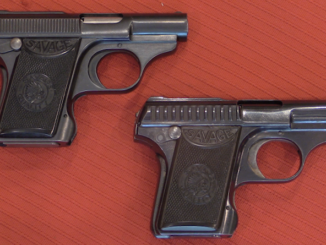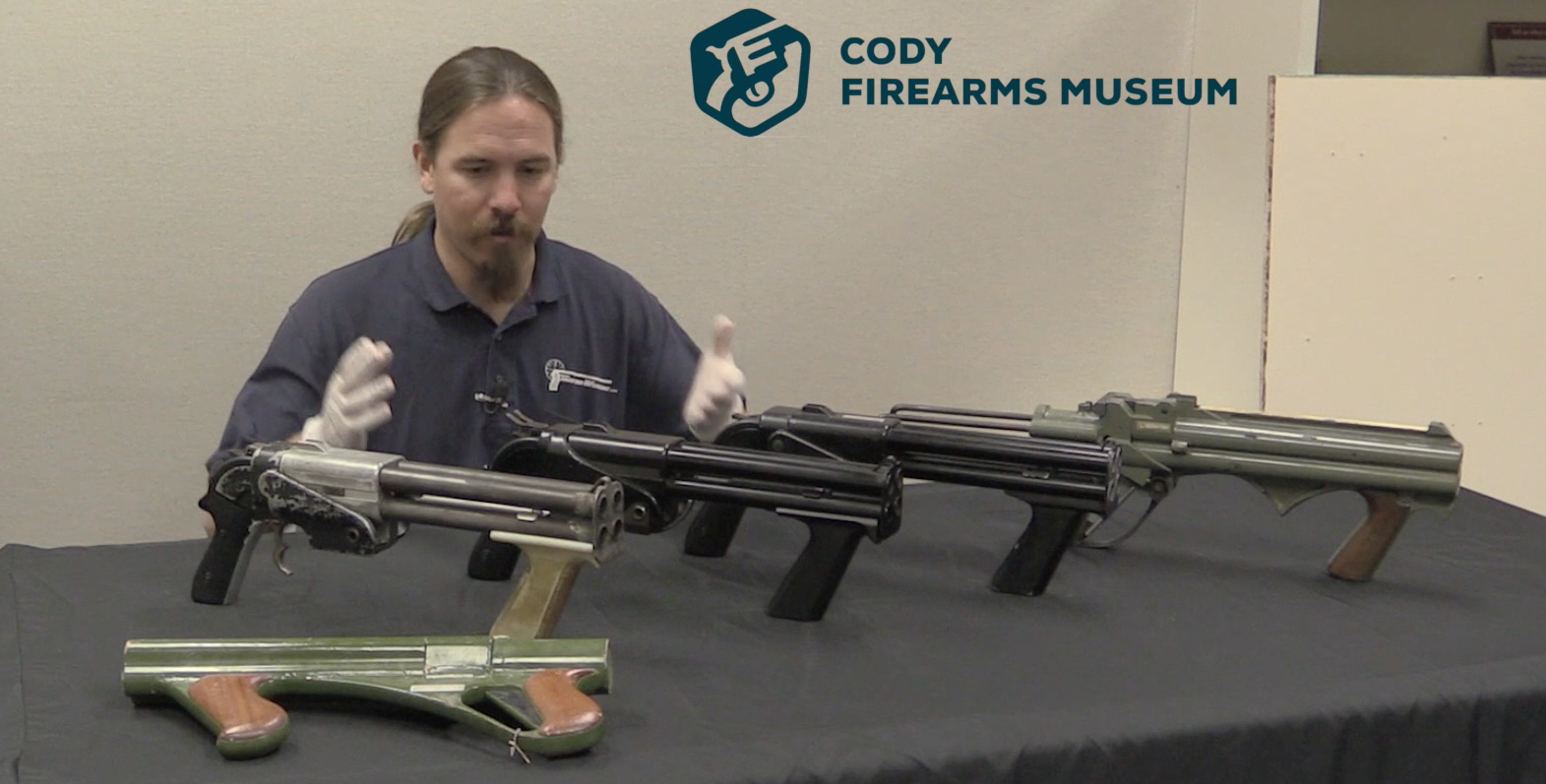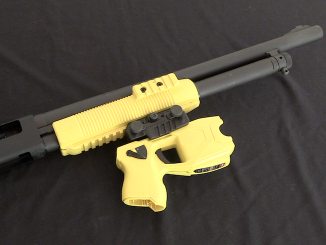This Benet-Mercie is being sold by Morphys on October 30, 2018.
The first light machine gun adopted by the United States was the M1909 Benet-Mercie, made by the Hotchkiss company in France. The gun was adopted when the US military realized that machine gun doctrine reuqired different guns for the light and heavy roles, and the M1904 Maxim gun was only suitable for use in the heavy role. Less than 2,000 of the M1909 guns were acquired, virtually all of them being made under license by Springfield Arsenal and the Colt company. They were used as training guns by US forces mobilizing for World War One, but did not see combat in that war. Indeed, the only action of note the Benet-Mercie saw was in Pancho Villa’s 1916 raid on the town of Columbus, New Mexico.




Had the production been greater, American machine gunners wouldn’t need to borrow so much from British and French troops. The question is how to make the action mud resistant, as any gun with open spots near the feeding area risks mud getting into the works. I would propose a detachable magazine set but that would be more expensive than a set of feed strips.
Not so fast, such method of feeding has advantages, ad it allows higher practical Rate-of-Fire and lighter weight for same quantity of cartridge (assuming capacity of tray and of magazine are equal).
British variant of HOCTHKISS PORTATIVE could use “semi-rigid” belt, see 2nd photo from top:
http://modernfirearms.net/en/machineguns/france-machineguns/hotchkiss-portative-eng/
though I don’t know allowed minimal radii* for that belt, why radii? Because I don’t know if this value is equal in both directions (notice that HOTCHKISS PORTATIVE tray has “upper” and “lower” sides and it would not work if placed inverted i.e. upside-down)
* you might imagine wounding belt around pipe, what is minimal external diameter of pipe for which it is possible?
Even if not very popular such feed system was later used in machine guns namely Italian Breda Modello 37 and Japanese Type 92. Interestingly Empire of Japan deployed weapon similar to your proposal namely Type 96:
http://modernfirearms.net/en/machineguns/japan-machineguns/type-96-type-99-eng/
which was child of HOTCHKISS design but with box magazine sticking upward rather than waiting for insert trays. Though it should be noted that globally it was not first magazine Hotchkiss, as earlier existed Mitrailleuse Hotchkiss de 13,2 mm modèle 1929, also featuring magazine sticking upward.
The feed strip had two advantages at the time. First of all, it was lighter than a 200-to-250-round belt, and so worked better through guns like the Hotchkiss that didn’t have sufficient “belt pull” to handle heavier weights in the ammunition feed.
Second, unlike a box magazine or a fabric belt (as on the Vickers-Maxim at the time), mud, dirt and other crap didn’t get stuck in the feed strip as easily. And if necessary, could be removed in a hurry by just dousing it with water and shaking it off.
As for the odd bipod, notice the spikes on the feet. They were to drive into the soil and ensure that the bipod didn’t shift. The bipod folding almost horizontally forward was to allow it to be rested on the parapet of a gun pit (or later a slit trench) and thus allow the gun to be fired while presenting a much lower silhouette to the enemy. The backward fold was of course to allow it to be secured for carriage by those brackets and spring clips either side of the forend/gas piston assembly.
The Hotchkiss Portative (which is what the M1909 actually is) was probably overall a better gun than the Lewis Gun. At least General Hatcher thought so, as he trained gunners on both at Ft. Hood, TX in 1916, and after he got done, they almost universally preferred the M1909 to the Lewis gun. It was however a precision instrument, in many ways a cross between a true “machine rifle” and a sniper rifle, that demanded a higher degree of skill from the operator than the Lewis did.
Incidentally, the M1909 was used against Mexican bandits at more places than just Columbus, NM. During the Punitive Expedition, it was used by Pershing’s troops, both as a light MG and mounted by that tripod adaptor on not only the Vickers tripod, but also on a pedestal mount on Ford trucks.
cheers
eon
Fabric belts are also problematic in winter conditions, especially around the freezing point of water (i.e. 0°C). If the belt becomes moist, which is often very difficult to prevent in field conditions, it will then freeze in place when temperature drops below freezing and feeding it into the action becomes very difficult.
The first Lewis Guns tested by the US Army had so many problems that the gunners gave up trying to fix them. No wonder Crozier said he had legitimate reasons against adopting the Lewis Gun for service. As for the M1909, I could imagine it being used just like the better of the Nambu machine guns (long range burst fire against priority targets like officers, harassment, and the like). Too bad production was so limited, otherwise we’d see it being simplified and improved for better manufacturing and field service (and I wonder what optical sight would have been best with it).
Keep in mind that the Japanese Taisho 3rd Year (1914), Type 11 (1922), Type 91 (1931), Type 92 (1932), Type 96 (1936), and Type 99 (1939) Army machine guns were all variants of the Hotchkiss Model 1900 themselves.
The Type 99 is often mistaken for a ZB26 type, but if you look closely at it there’s the characteristic Hotchkiss mechanism inside; it just looks more “ZB-like” externally. The Type 97 (1937) tank machine gun was in fact a ZB26 “clone”.
Interestingly, the postwar Japanese Type 62 (1962) GPMG in 7.62 x 51mm NATO looks a lot like an FN MAG on the outside, but internally it is an almost direct copy of the Lewis Gun.
This may be less surprising when you consider that the Imperial Japanese Navy used a copy of the Lewis as their own Type 99 (not the same as the Army gun)right through WW2.
It was even chambered for their own version of the 0.303in Enfield round,which made no less than three distinct and non-interchangeable “standard” rifle-caliber rounds called 7.7 x 58mms in their inventory- one rimless, one semi-rimmed, and one fully rimmed.
Their storeskeepers must have used a lot of aspirin.
cheers
eon
” Crozier”
For more data see chapter The Controversy over the Lewis Gun in America here: https://www.ibiblio.org/hyperwar/USN/ref/MG/I/MG-4.html#2
especially:
During his[i.e. Lewis] demonstrations abroad, British and Belgian ordnance officers pointed out that his rate of fire was far above what was considered ideal for battle use. In order to reduce the rate, the straight portion of the cam slot was redesigned until it had a free travel or “dwell” of 1.0625 inches. The additional free movement permitted the chamber pressure to drop before the bolt started to relax behind the base of the cartridge. It also established an average rate of fire of around 600 shots per minute when used in conjunction with a fixed gas orifice of .130, a dimension that produced a satisfactory rate of fire and the smoothest performance.
As England was at war and the most trivial thing concerning machine-gun construction was considered top secret, it is easy to understand why information on this redesigned part was not made available. In fact it is possible that the change may have been made by engineers of the Birmingham Small Arms Co. when the manufacturing drawings were converted from our measurements to the metric system and that Colonel Lewis did not even know of it.
“Imperial Japanese Navy used a copy of the Lewis as their own Type 99 (not the same as the Army gun)right through WW2. ”
Wait, so far I know IJN’s Lewis got name TYPE 92
https://en.wikipedia.org/wiki/Type_92_machine_gun
While TYPE 97 was IJN’s Vickers belt-fed machine gun
https://en.wikipedia.org/wiki/Type_97_aircraft_machine_gun
“Their storeskeepers must have used a lot of aspirin.”
My I add that Yokosuka D4Y armament contained 2 Type 97 and 1 Type 1 machine gun. Two different models – ok, but they use different ammunition (7,7 mm for Type 97 and 7,92 mm for Type 1)
Sometimes I really start to believe Japanese before and during WWII were thinking “more complicated is better”, take for example this machine gun:
http://guns.wikia.com/wiki/Type_89_machine_gun
while the gun itself is not untypical take note how its magazine work, very complicated for capacity of 45 cartridges (for each gun, 90 together)
The Type 1 observer’s MG on the D4Y was apparently chosen because it had a much higher RoF than the earlier Type 92 flexible MG of the IJN. Type 1 was a copy of the MG 15 with 1000 rpm. Since the Type 92 fired only about 600 rounds per minute, I can certainly see why the Type 1 would have been preferred.
“worked better through guns like the Hotchkiss that didn’t have sufficient “belt pull” to handle heavier weights in the ammunition feed.”
According to http://modernfirearms.net/en/machineguns/france-machineguns/hotchkiss-m1914-eng/
Hotchkiss 1914 could also use 251-round semi-rigid steel belts, while Hotchkiss Portative is said to able to use 50-round semi-rigid belt, which was used in early tanks. But I do not know reason for usage of shorter belt in Portative: did it has less pulling power or it was due to confined space in then used tanks?
It may simply have been that as a light gun used by infantry, it was easier to carry with just a 25-round strip inserted. Consider WW2 German MG34 and MG42 gunners literally draped with belts of 7.9 x 57 for the guns. Even carrying the saddle drum magazines could be a bit of a weighty issue.
Don’t forget that prior to Flanders, the concept of infantry warfare was predicated on mobility. And mobility for infantry back then meant “on foot”.
cheers
eon
As you mentioned, the 1909 and more so 1914 Hotchkiss models, inheritors of von Odkolek original patent, were indeed advanced for its time. It does not surprise me that col. Hatcher preferred them over Lewis gun.
One feature which impresses me most is the pressure reducing gas tap/ regulator mechanism. It permits, due to substantial gas pressure reduction to vary RoF according to requirement of user.
“One feature which impresses me most is the pressure reducing gas tap/ regulator mechanism. It permits, due to substantial gas pressure reduction to vary RoF according to requirement of user.”
According to http://modernfirearms.net/en/machineguns/france-machineguns/hotchkiss-m1914-eng/
Rate-of-Fire is 500…600 rpm, thus I presume it was implemented rather to adjust to actual fouling of weapon, rather than be able to choose Rate-of-Fire, though indeed for ideally clean weapon it will affect Rate-of-Fire. Notice that Saint-Étienne modèle 1907 has Rate-of-Fire regulator allowing 60…600 rpm.
I would say important part of Hotchkiss international success was ability to scale basic design. Take for example following weapons:
13,2 mm Hotchkiss (13,2×99 cartridge)
20 mm Breda Modello 35 (20×138 B Long Solothurn cartridge)
25 mm Type 96 (25×163 cartridge)
37 mm Breda (37x232R cartridge)
which are up-scaled versions of basic Hotchkiss design
is: “(…)implemented rather to(…)”
should be: “(…)implemented to(…)”
Hi I have a few questions about a rifle I acquired and was wondering if you could help me
If I’m not mistaken, Ishapore India made (and still might)a modernized box magazine version of this design. At least into the 7.62 NATO era. Anyone at Ishapore follow Ian’s site?
https://www.youtube.com/watch?v=NKxSkNxVVBE
Vickers-Berthier?
Dave was faster!
Do you mean the Vickers-Berthier Mk III? It was indeed made by the Ishapore Rifle Factory. I don’t know if they continued production into the 7.62 NATO era, but the Mk III chambered for the .303 cartridge survived well into the 70s.
By the way, the Berthier (Vickers took up the design after 1918) was an independent development, by French designer André Berthier (of carbines and rifles fame) who started working on it around 1905.
The later marks of the Vickers-Berthier, manufactured by both Vickers and Ishapore, are very interesting guns that perhaps deserved a better fate in the export market. Besides from the Indian army, who used it in rather substantial numbers, the V-B was only exported in the late 20s/early 30s to Bolivia, Latvia and Portugal.
Great feature as usual, Ian. The ”2 foot monopod” had me laughing though. Kinda contadictory as monopod means ”one foot” Gotta admit, it’s a strange feature.
Similar solution (inverted “T”) might be found in early Boys AT rifles cf. https://www.youtube.com/watch?v=9iL_6IyH9gs
As side note in ancient time “monopod” was used to describe something totally different…
https://en.wikipedia.org/wiki/Monopod_(creature)
In my boyhood, you could buy one of these old irons MAIL ORDER! Ye Olde Hunter advertised them in American Rifleman, along with great numbers of other guns and gear, in full-page ads. Of course, the price was way out of my family’s class — not that we would have indulged anyway.
No disassembly, no explaining of the mechanics etc?
Mechanics: https://www.youtube.com/watch?v=fU1xzzyugew
Disassembly of AUTOMATIC MACHINE RIFLE CAL.30, MODEL OF 1909
https://www.youtube.com/watch?v=7x6RH-kPvmA
(skip to 5:30)
I’ve owned 4 or 5 of them and at least one was a great shooter. It is a shame Ian didn’t take it apart as the firing pins and bolts are real works of art. Many in the US were deactivated and what kept them from being rewatted was the complexity of the firing pin. Feed strips are also next to impossible to find. The Colt guns with the knereled barrels were very neat. I had never seen thetripod attachment before. For some reason, and I’d have to dig thru files, I was sure 750 were produced for the US military with about half Colt and half Springfield. I had never heard of a Navy one until today. The highest SN I’d ever seen was 577, which was a Springfield gun.
No takedown? WTF
Check the archives, Ian did take one down years ago:
As very much a precision built gun and loaded with US only / specified add ons. How much did it cost ? It would be interesting to compare its price to the Madsen or Lewis (+ any other contempory light machine guns that might have been around).
Please tell me when this piece is being put up for auction, I have been looking for one of these for years.
Oct. 30. It was a very nice package but don’t know what it sold for.
It was lot #49, sold for $33,825.
Buying Essays Online – What to Watch for: https://vk.cc/9OTGak?id=buyessayonline111s99
My impression is providing small arms in multiple calibers was considered “easy.” Bolt actions, etc. For various automatic repeating arms cartridge choice and adaptation, especially when ” rushed” seems to play a big part in success of failure.
On a theoretical basis the Lewis, at the time, seems better/more useful (at least in .303). There were effective strip fed machine guns developed and used. Just not sure the 1909 as manufactured at the time (including strips) was as good as it can be demonstrated “now.” We are not under field conditions of the time.
perhaps a n uninformed concern?
I recently stumbled across the below on the internet, that might be of interest =
US official test/trials report 1911 – a rifle of this model complete in every respect inc. the royalty & its proportional part of spare parts, accessories & arm chests costs –
Springfield Armory – $559.28/£115 (1914 £1 = £4.867)
Colt P.F.A. Mfg. Co. – $746.22/£153
Benet & Mercie – $915.81/£188.
Ditto Madsen approximately £140 and the early Lewis £135.
All would have been a tough sell – though more mobile. There was no agreed tactical role for them and they produced less firepower than a medium machine gun, That cost effectively the same amount.